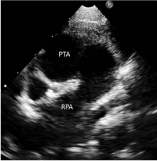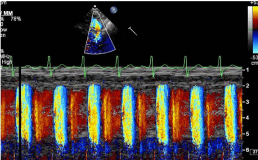Case Report
Single Lung Repair for Truncus Arteriosus: A Case Report Defining Issues
Neeraj Awasthy*, Savitri Shrivastava and KS Iyer
Department of Cardiology, Fortis Escorts Heart Institute, India
*Corresponding author: Neeraj Awasthy, Department of Cardiology, Fortis Escorts Heart Institute, 123, Anandkunj, Vikaspuri, New Delhi, 110018, India
Published: 08 Nov, 2016
Cite this article as: Awasthy N, Shrivastava S, Iyer KS.
Single Lung Repair for Truncus
Arteriosus: A Case Report Defining
Issues. Clin Surg. 2016; 1: 1175.
Abstract
Persistent Truncus arteriosus (TA) and Tetrology of Fallot is commonly associated with unilateral absence of branch pulmonary arteries. Of these two TA being a high flow and high pressure situation has early setting of worsening pulmonary vascular resistance. Thus operability and management remains an issue of contention in such a case of TA. Also of concern in long term outcome of these subgroup of patient whenever they are operated and more so when they undergo surgery in post infancy period. We describe a case of TA with absent left pulmonary artery followed up for four years.
Case Presentation
A 2 year 8 months, 9 kg child 1st in birth order, product of full term normal vaginal delivery with average birth weight. The baby was suspected of having congenital heart disease in view of murmur detected during evaluation for upper respiratory infection in newborn period but no follow up was done. On examination child was tachypnoic with respiratory rates of 54/minute and heart rate of 98/minute, systemic blood pressure of 98/46/62 mmhg and systemic saturation of 90%. She had loud first heart sound and single and loud second heart sound with mid-diastolic murmur present at the apex. She also had features of congestive heart failure (CHF). Chest x ray showed cardiomegaly and increased vascularity with cardiothoracic ratio of 70%. Echocardiography done revealed single outlet truncus arteriosus, non-restrictive ventricular septal defect, and quadricuspid truncal valve trivial truncal valve regurgitation left pulmonary artery was not seen. RPA=12.5 mm (Exp=7 mm), no atrio ventricular valvular regurgitation, good pulmonary venous return flow and pan diastolic reversal in arch was present. Left ventricular end diastolic dimension (LVIDd)=3.9 (Z score= +5.2). After administration of Oxygen for 10 mins LVIDd was increased to 4 (Z score= +5.6). Also there was bilateral SVC with the left superior vena cava (LSVC) was unroofed. In view of presence of congestive heart failure, cardiomegaly and saturation of 90% he was taken up for surgical correction. The cardiac catherization was not done because with single lung the calculation of corrected pulmonary vascular resistance is highly fallacious. Child underwent Truncus arteriosus repair (Dacron patch closure of ventricular septal defect using 16 mm Contegra conduit from right ventricle to right pulmonary artery, LSVC opening draining into left atrium closed from inside the left atrium through sternotomy. Her post operative course was prolonged in view of bilateral extensive atelectasis and post operative pulmonary hypertension needing prolonged invasive and noninvasive ventilatory support. She was ventilated for 46 hours with need of prolonged noninvasive ventilator support and discharged after 28 days. Echocardiography done at discharge showed VSD patch in situ, normal flow in right ventricular outflow tract gradient (rvot) and pulmonary artery, there was mild tricuspid regurgitation with peak pg 30 mmhg and normal ventricular function and dimensions. Follow up at 4 years the child was asymptomatic. On examination there was no chf or evidence of pulmonary artery hypertension. Echocardiography showed laminar flow in rvot with normal pulmonary artery pressures with TR gradient of 30 mmhg.
Figure 1
Figure 1
2d echocardiography in parasternal short axis view showing single outflow truncus arteriosus type 1 giving rise to right pulmonary artery. RPA: right pulmonary artery, TA: single outflow truncus arteriosus.
Figure 2
Figure 2
Continuous wave Doppler across the arch Suprasternal view showing pan-diastolic flow reversal across the arch.
Discussion
Operability in case of admixture lesions is a matter of debate [1]. PTA is post-tricuspid admixture lesion at the level of the great arteries, with the mixing chamber predominantly being the common outlet truncus. Streaming is well documented in truncus arteriosus and can result in substantial difference in aortic and pulmonary arterial saturations. Also the physiology gets markedly influenced by degree of branch pulmonary artery stenosis, degree of truncal valve regurgitation, pulmonary vascular disease and more so in the absence of unilateral branch pulmonary artery as is our case. Important criteria when deciding for operability in these cases include degree of pulmonary venous return, dilatation of left atrium and left ventricle and significant flow reversal in the arch of aorta, with wide pulse pressure in the absence of significant truncal regurgitation. Arterial saturation of 85% or more. A clinical evaluation as was present in our case which suggest increased flow through the pulmonary vascular bed and hence increased venousreturn such as cardiomegaly and presence of apical diastolic murmur suggest low resistance circuit. Also the presence of good systemic saturation more than 85% is again a pointer of operability as was present in our case. The accurate assessment of pulmonary vascular resistance although of vital importance in any such scenario is highly fallacious. While surgical results are worse for patients with high PVR, the progression to high PVR is common with late operated patients with single lung physiology. A study of 40 patients from Mayo clinic (37 with two pulmonary arteries and three with single pulmonary artery) showed significant relationship between pulmonary resistance and operative mortality, and postoperative histological examination of the lungs in surgical deaths showed excellent correlation between the calculated preoperative pulmonary resistance and the degree of pulmonary arteriolar disease. The data though indicative on cardiac catheterizations is highly fallacious, more so by the presence of selective streaming to the pulmonary vascular bed [2-4]. Our present case highlights that a good clinical evaluation is indispensible and most important parameter to decide operability in such a case PTA with single lung repair and this gets further validated by a maintained pulmonary artery resistances in midterm follow up.
References
- Awasthy N, Shrivastava S. Bedside Approach to Admixture Lesion. Cardiology Today. 2014.
- Mair DD, Ritter DG, Danielson GK, Wallace RB, McGoon DC. Truncus Arteriosus with Unilateral Absence of Pulmonary Artery Criteria for Operability and Surgical Results. Circulation. 1977: 55; 641-647.
- Mair DD, Ritter DG, Davis GD, Wallace RB, Danielson GK, McGoon DC. Selection of patients with truncus arteriosus for surgical correction; anatomic and hemodynamic considerations. Circulation. 1974; 49: 144- 151.
- Marcelletti C, McGoon DC, Danielson GK, Wallace RB, Mair DD. Early and late results of surgical repair of truncus arteriosus. Circulation. 1977; 55: 636-641.


